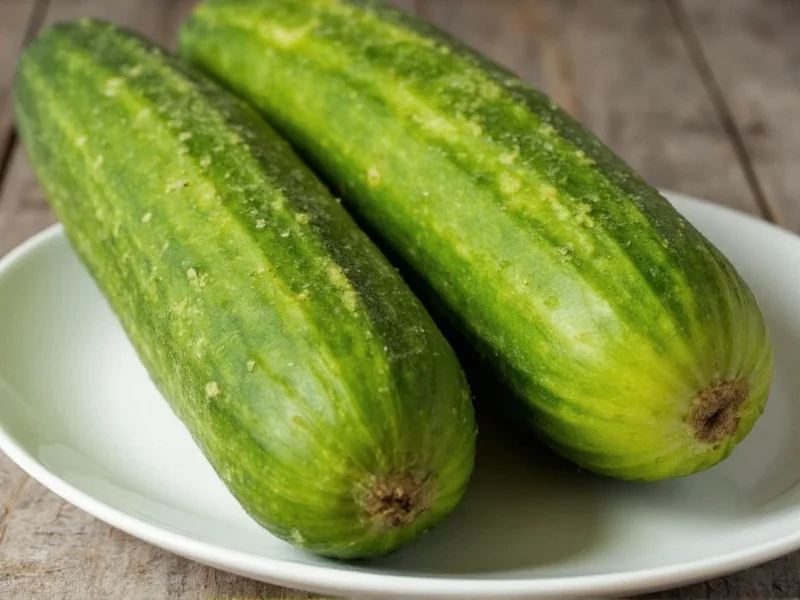Here's the direct answer: A pickle is a cucumber that has been preserved through a process called pickling, typically using vinegar, salt, and spices. All pickles start as cucumbers, but not all cucumbers become pickles. The key difference lies in the preservation process that transforms a fresh cucumber into a tangy, longer-lasting pickle.
Understanding the distinction between cucumbers and pickles is fundamental to appreciating food preservation techniques that have been used for centuries. While many people use these terms interchangeably, they represent different stages in a vegetable's lifecycle. Let's explore this culinary transformation in detail.
What Exactly Defines a Cucumber?
Cucumbers are fresh vegetables belonging to the Cucurbitaceae family, which also includes squash and melons. They're characterized by their high water content (approximately 95%), crisp texture, and mild, slightly sweet flavor. Available in various types including slicing cucumbers (like the common garden cucumber) and pickling cucumbers (typically smaller and firmer), these vegetables are enjoyed raw in salads, sandwiches, and as refreshing snacks.
The Transformation: How Cucumbers Become Pickles
The journey from cucumber to pickle occurs through a preservation method known as pickling. This process involves submerging cucumbers in a solution that typically contains:
- Vinegar (for quick pickles)
- Brine (salt water solution for fermented pickles)
- Spices and herbs (dill, garlic, mustard seeds)
- Sometimes sugar for balance
During pickling, chemical changes occur that transform the cucumber's characteristics. The acid in vinegar or the lactic acid produced during fermentation alters the vegetable's texture, flavor profile, and preservation qualities. This process can take anywhere from a few hours (for refrigerator pickles) to several weeks (for traditionally fermented pickles).
| Characteristic | Cucumber | Pickle |
|---|---|---|
| Texture | Crisp, watery | Firmer, less watery |
| Flavor Profile | Mild, slightly sweet | Tangy, sour, often spiced |
| Shelf Life | 1-2 weeks refrigerated | Months to years when properly canned |
| Nutritional Content | Low calories, high water content | Lower sodium varieties available, but often higher in sodium |
Types of Pickles vs. Cucumber Varieties
Not all cucumbers are equally suitable for pickling. Specific varieties have been developed for optimal pickle production:
Cucumber Varieties
- Pickling cucumbers: Shorter, thicker, with bumpy skin (like Kirby cucumbers)
- Slicing cucumbers: Longer, smoother skin (like English cucumbers)
- Lemon cucumbers: Round and yellow, sometimes used for specialty pickles
Pickle Types
- Dill pickles: Flavored with dill weed and garlic
- Sweet pickles: Contain sugar in the brine
- Bread and butter pickles: Sweet and tangy with onions
- Gherkins: Made from small, young cucumbers
- Fermented pickles: Naturally preserved through lacto-fermentation
Nutritional Differences Between Pickles and Cucumbers
While both originate from the same vegetable, the pickling process creates notable nutritional changes:
- Sodium content: Pickles typically contain significantly more sodium due to the brine solution
- Vitamin content: Some vitamins (like vitamin C) decrease during pickling, while others remain stable
- Probiotics: Naturally fermented pickles contain beneficial bacteria not found in fresh cucumbers
- Calorie count: Generally similar, though sweet pickles may contain added sugars
For those monitoring sodium intake, "low-sodium" or "no-salt-added" pickle varieties are increasingly available. Conversely, individuals seeking probiotic benefits might prefer traditionally fermented pickles over vinegar-based varieties.
Common Misconceptions About Pickles and Cucumbers
Several misunderstandings persist about the relationship between these two food items:
- Misconception: Pickles are a different vegetable than cucumbers Reality: Pickles are cucumbers that have undergone preservation
- Misconception: All pickles are sour Reality: Sweet pickles contain significant sugar to balance the vinegar
- Misconception: Pickling destroys all nutritional value Reality: While some nutrients change, pickles retain many beneficial compounds
- Misconception: Only cucumbers can be pickled Reality: Many vegetables undergo pickling, but "pickle" without specification refers to pickled cucumbers
Practical Applications in Cooking
Understanding the difference between cucumbers and pickles helps in culinary applications:
- Use fresh cucumbers when you want crisp texture and mild flavor in salads or sandwiches
- Choose pickles when you need tangy flavor, longer shelf life, or specific texture
- Substitute cucumber slices with dill pickles in recipes for added flavor dimension
- Remember that pickles' higher sodium content affects overall dish seasoning
Home preservation enthusiasts can experiment with different cucumber varieties, brine recipes, and fermentation times to create custom pickle flavors that suit their preferences.











 浙公网安备
33010002000092号
浙公网安备
33010002000092号 浙B2-20120091-4
浙B2-20120091-4